Recent court rulings have markedly altered Bay Area gun ownership rights. The San José insurance mandate for gun owners was upheld, requiring liability coverage for accidents and injuries. Concealed carry permits no longer need "good cause," though training requirements remain. An 11% excise tax impacts firearm prices and dealer operations. Data sharing with researchers is now permitted despite privacy concerns. These changes mark the beginning of a complex shift in regional firearm regulations.
Key Takeaways
- San José's groundbreaking liability insurance mandate for gun owners was upheld by federal courts, establishing a precedent for similar regulations.
- The elimination of "good cause" requirements for concealed carry permits has made the application process more objective and standardized.
- Courts now permit firearm owner data sharing with researchers, though strict privacy protocols and encryption standards must be followed.
- The Bruen decision prompted federal courts to block California's ban on carrying firearms in most public places.
- Recent rulings have maintained restrictions on felon possession while requiring courts to examine individual risk rather than blanket bans.
The Landmark San José Insurance Mandate
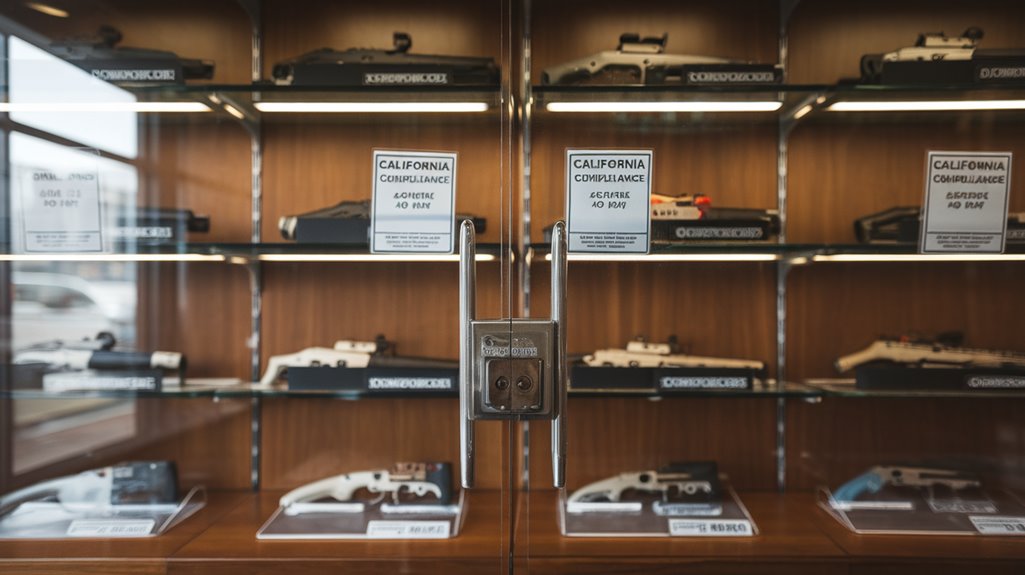
The San José Gun Harm Reduction Ordinance marked a significant shift in U.S. firearm regulation when it passed in January 2022. As the first jurisdiction to mandate liability insurance for gun owners, the law requires coverage for accidental discharge, injury, and property damage.
The ordinance faced legal challenges from pro-gun groups, but a federal court upheld its constitutionality in October 2022, dismissing most claims. While the insurance coverage requirement took effect in January 2023, the annual $25 fee remains pending. The fee will support gun safety programs, mental health services, and suicide prevention initiatives.
Key provisions include exemptions for police officers and concealed carry permit holders, along with financial waivers for low-income households. Noncompliance results in fines starting at $250.
Navigating Privacy Concerns in Research Data Sharing
Recent court decisions allowing firearm owner data sharing with researchers have sparked significant privacy concerns among gun rights advocates. Research institutions must follow strict data protection protocols, including data anonymization and secure storage requirements, when accessing sensitive gun ownership records. The challenge lies in balancing legitimate research needs for public health studies with gun owners' expectations of privacy and data security.
Data Protection Safeguard Protocols
As concerns mount over gun ownership data security, research institutions have implemented extensive safeguard protocols to protect sensitive information. Data encryption standards like AES-256 and strict file separation protocols form the foundation of privacy safeguards for firearms data.
Research facilities must demonstrate robust security capabilities before accessing datasets, with Level 3 data requiring quarterly audits and encrypted storage. Systems track all user activity and enforce strict access controls, while staff undergo mandatory ethics training. Secure platforms separate identifying information from health data to minimize breach exposure.
Physical security measures extend to portable devices, which require immediate encrypted data transfer to protected networks. These protocols align with institutional review board (IRB) requirements and restricted use agreements that govern sensitive data handling.
Public Trust Vs Research
Steering the balance between public trust and scientific research has emerged as a critical challenge in firearms data sharing. Public opinion surveys reveal significant concerns, with up to 60% of respondents opposing third-party access to personal data. Privacy advocates argue that data sharing represents a severe intrusion, particularly without explicit consent.
Ethical considerations underscore the importance of transparent governance and accountability measures. Studies show that trust levels increase from 74% to 81% when individuals have control over their data through consent mechanisms. Research institutions like UC Davis face the challenge of maintaining public confidence while pursuing crucial studies on firearm violence patterns. The implementation of strict data protection protocols and clear communication about research objectives has become essential for bridging the gap between scientific needs and privacy concerns.
Economic Impact of New Firearm Taxation

The new firearms tax structure in California has sparked significant economic ripples throughout the industry. The 11% excise tax on dealers and manufacturers creates an immediate economic burden, with projected annual revenue of $159 million earmarked for violence prevention programs.
Small businesses face particular challenges as the tax exceeds typical industry profit margins. While establishments with quarterly sales under $5,000 receive exemptions, larger dealers anticipate passing costs to consumers. The tax implications suggest approximately 10% price increases on firearms, based on 2020 average purchase data of $600. This cost shift threatens business viability, potentially leading to industry consolidation and closures. In addition, the extended legal battles, exemplified by cases like Nordyke v. King, add substantial financial strain through mounting legal fees.
Changes to Concealed Carry Requirements
Recent court rulings have fundamentally altered California's concealed carry weapon (CCW) permit requirements. The state eliminated subjective "good cause" standards, replacing them with objective licensing standards that focus on specific criteria like age, residency, and training completion.
| Requirement | Details |
|---|---|
| Age | 21 years or older |
| Training | 8-hour mandatory course |
| Background | No felonies or mental health restrictions |
| Restrictions | No carrying in sensitive places |
Local enforcement varies considerably across counties. While San Francisco maintains strict "significant risk" requirements, rural counties like Sacramento and Tehama routinely issue permits to qualified applicants. All CCW licenses must now specify prohibited locations, including schools, hospitals, and transit hubs. The appeals process allows judicial review for permit denials under constitutional standards.
Legal Framework for Felon Possession Restrictions
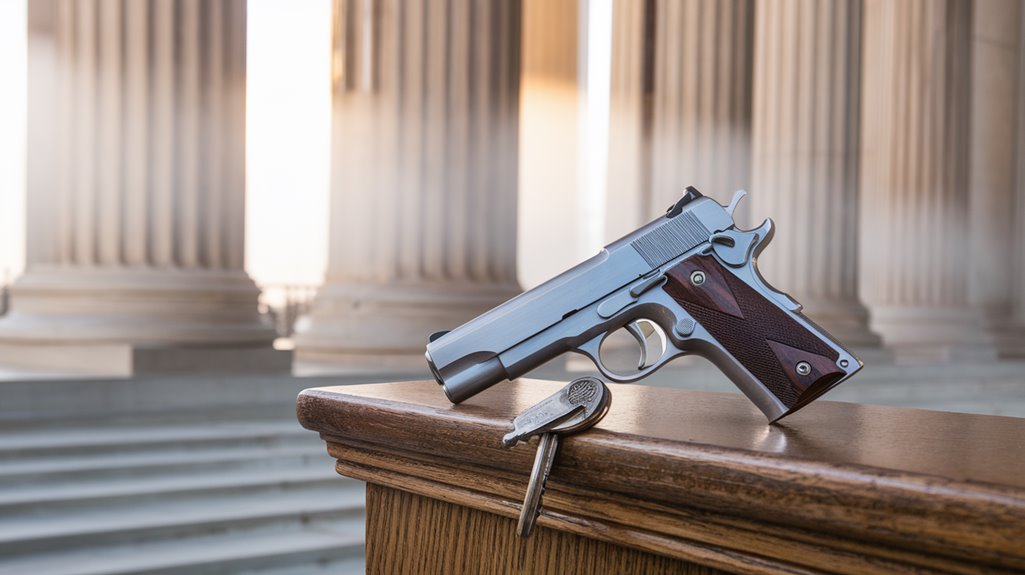
Federal and state laws establish strict prohibitions on firearm possession by convicted felons. California Penal Code 29800 enforces lifetime firearm restrictions on felons, applying to all types of weapons. However, recent legal challenges following the Supreme Court's Bruen decision have sparked debate over these restrictions' constitutional validity.
Courts now require prosecutors to demonstrate historical context for felon rights limitations, shifting away from modern public safety arguments. This has led to increased judicial trends examining individual risk rather than blanket bans. The surge in court challenges has created new pathways for restoration processes, particularly for nonviolent offenders. Policy implications remain complex as courts balance public perception with constitutional rights. Current court interpretations suggest a possible narrowing of felon firearm restrictions, especially for those deemed low-risk.
Public Safety Programs Funded by Gun Fees
Thorough public safety initiatives draw funding from multiple gun-related fees in California. The state's Department of Justice collects $37.19 for each firearm transfer through DROS fees, supporting background checks and registry maintenance. Additional revenue streams include private-party transfer fees of $10, gun safety act fees of $1, and enforcement fees of $5 per transaction.
Funding allocation extends to programs like San Francisco's Dream Keeper Fellowship, which provides monthly stipends to high-risk individuals. Program effectiveness is measured through reduced violent incidents and participant progress. The initiative requires life coaching and goal-setting, with spending monitored through gift cards. UC Davis's Firearm Violence Research Center utilizes these funds to study and refine evidence-based violence prevention strategies.
Enforcement Mechanisms and Local Authority
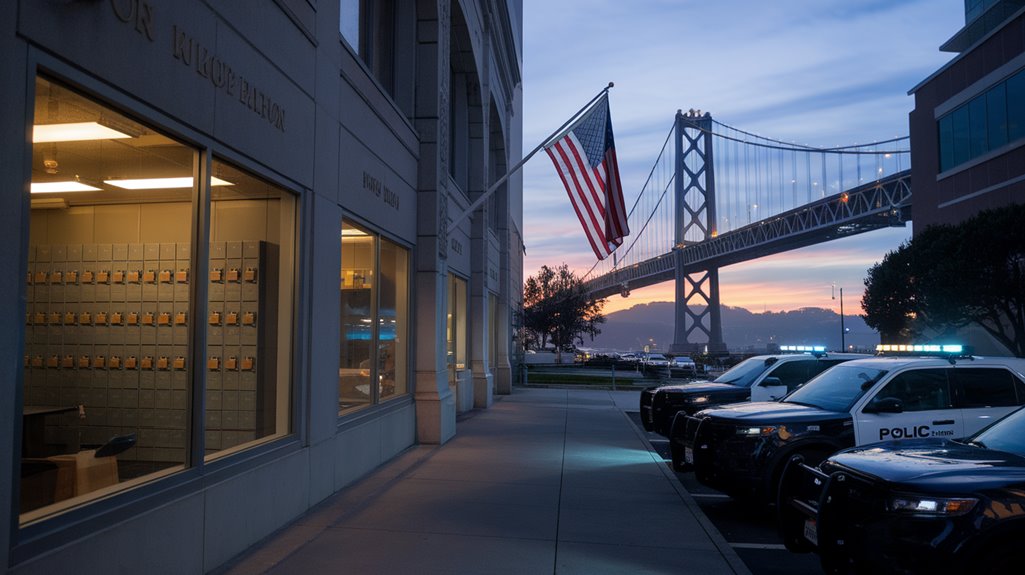
While public safety programs receive funding from gun-related fees, the enforcement landscape has shifted dramatically following key court decisions. Local enforcement agencies now navigate complex jurisdictional challenges amid federal injunctions and state-level pushback. Cities like San José have implemented their own authority through measures requiring liability insurance and annual fees, despite broader legal uncertainty.
Key developments in local authority include:
- Mandatory 48-hour firearm relinquishment protocols with enhanced verification periods
- Real-time access to prohibited persons databases for law enforcement agencies
- Authority to impose civil penalties up to $10,000 for illicit sales
These enforcement mechanisms operate within a framework of authority challenges, as municipalities test creative approaches while respecting court mandates. Local chiefs continue adapting their protocols to align with evolving judicial standards and state regulations.
Research Collaborations and Data Protection
Recent court rulings have enabled broader data sharing for firearm research while establishing strict protocols for protecting sensitive information. California's mandate requiring state DOJ to share firearm records with research institutions has created new opportunities for studying gun violence, while implementing robust data governance frameworks.
Research institutions like UC Davis now utilize Trusted Research Environments (TREs) to analyze firearm data while maintaining research ethics and privacy standards. These secure platforms employ encryption, access controls, and anonymization techniques to protect sensitive information. The collaboration frameworks guarantee compliance with regulations while enabling meaningful research outcomes. Despite privacy concerns, courts have upheld the state's authority to facilitate firearm research, recognizing the balance between individual privacy rights and public health benefits through controlled data sharing mechanisms.
Merchant Compliance With New Tax Codes
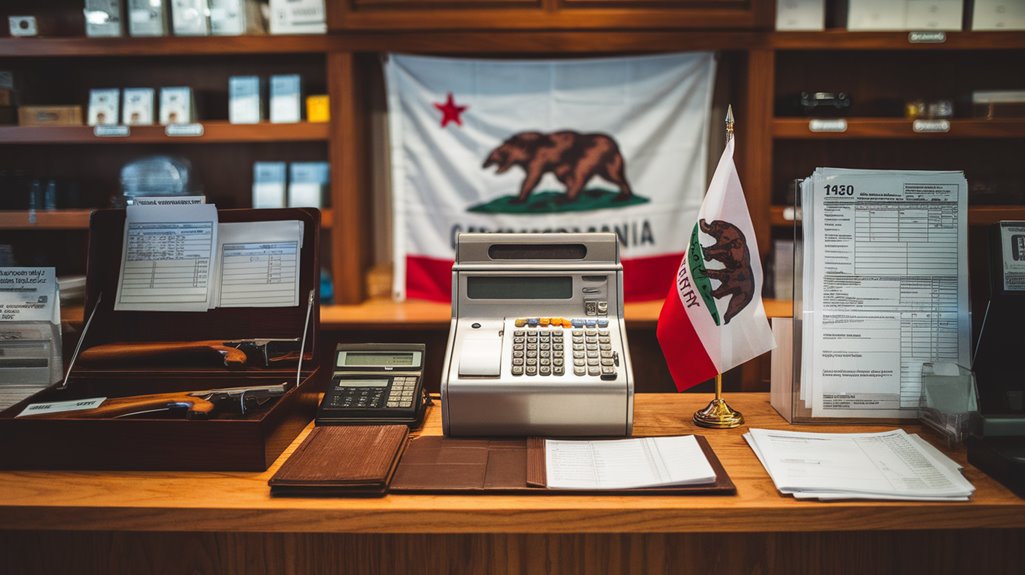
The implementation of new firearm merchant tax codes brings significant operational changes for retailers across the United States. Businesses must adapt their systems and processes to meet stringent compliance requirements by May 1, 2025. Merchant education initiatives and compliance technology upgrades are essential for successful implementation.
New firearm tax codes require major changes as retailers rush to update systems and meet 2025 compliance deadlines.
Key compliance requirements include:
- Installation of updated POS systems capable of processing ISC 3351 codes
- Documentation for exempt non-digital products and insurance waivers
- Implementation of dual tracking systems for transaction reporting
Many retailers are facing technical challenges with system compatibility and reporting requirements. Some merchants have installed ATMs to provide cash alternatives for customers concerned about transaction surveillance. The divide between states that mandate codes and those that prohibit them creates additional complexity for businesses operating across multiple jurisdictions.
Evolution of Permit Application Process
The permit application process underwent significant changes with the introduction of separate initial and renewal application forms in 2017. Online submissions through BreEZe now offer enhanced privacy protection while reducing processing times by up to two weeks. Training certification standards have evolved to include digital tracking of range qualifications and electronic DOJ form verification, creating a more efficient system for both applicants and administrators.
Streamlined Documentation Requirements
Since 2017, California's permit application process has undergone significant streamlining through updated documentation requirements. The Bureau of Security and Investigative Services (BSIS) introduced separate forms for initial and renewal applications, enhancing documentation clarity and reducing processing errors.
Key improvements in application efficiency include:
- Digital submissions through BreEZe platform, cutting processing time by up to two weeks
- Standardized renewal requirements with 60-90 day pre-expiration window
- Consolidated background checks using FBI/DOJ Live Scan integration
The new system mandates specific timeframes for range qualifications, allowing simulator use for one qualification per year. Fixed cost schedules remain competitive, with initial permits at $80 and renewals at $98. These changes reflect California's commitment to modernizing the permit process while maintaining security standards.
Address Privacy Options
Privacy concerns surrounding firearms permit applications have sparked significant changes in how personal information is protected during the submission process. The implementation of the BreEZe online portal has enhanced data anonymity while maintaining necessary verification protocols for citizenship and immigration documentation.
The system now employs privacy regulations that safeguard applicant information during both initial and renewal submissions. While applicants must still provide detailed documentation, including birth certificates and passports with issuing authority information, the electronic submission process offers improved security compared to paper applications sent through mail. The BreEZe portal's secure infrastructure guarantees sensitive personal data remains protected throughout the application process, from initial submission through background checks and final approval or denial.
Training Certification Standards
Recent court rulings have fundamentally transformed training certification standards for firearm permit applications across the United States. Training provider accountability now requires instructors to verify qualification data and submit DOJ form BOF 4040 with all certifications. The application timeline mandates completion of requirements 60 days before permit expiration.
Key changes to certification standards include:
- Mandatory completion of two live-fire training sessions annually, separated by at least four months
- Digital submission through the BreEZe platform, reducing processing time by two weeks
- Pre-submission Live Scan fingerprinting requirement to align with FBI/DOJ verification schedules
These requirements reflect the post-Bruen shift from subjective "good cause" standards to objective training criteria, while maintaining strict oversight of permit issuance processes.
Court Precedents Shaping Local Regulations
Federal court decisions have fundamentally reshaped how local jurisdictions regulate firearms, with landmark rulings in *District of Columbia v. Heller* and *McDonald v. Chicago* establishing constitutional baselines for gun ownership rights. While these decisions protect individual right to bear arms, they allow reasonable regulations including restrictions for felons and mental health cases.
Recent court challenges have prompted legislative responses across the Bay Area. San José's Gun Harm Reduction Ordinance, requiring insurance and fees from gun owners, survived multiple legal challenges and now serves as a model for other cities. The state's implementation of an 11% excise tax on firearms and ammunition sales demonstrates how local jurisdictions can navigate federal precedents while maintaining public safety measures. These regulations reflect ongoing efforts to balance constitutional rights with community protection.
Community Response to Policy Changes
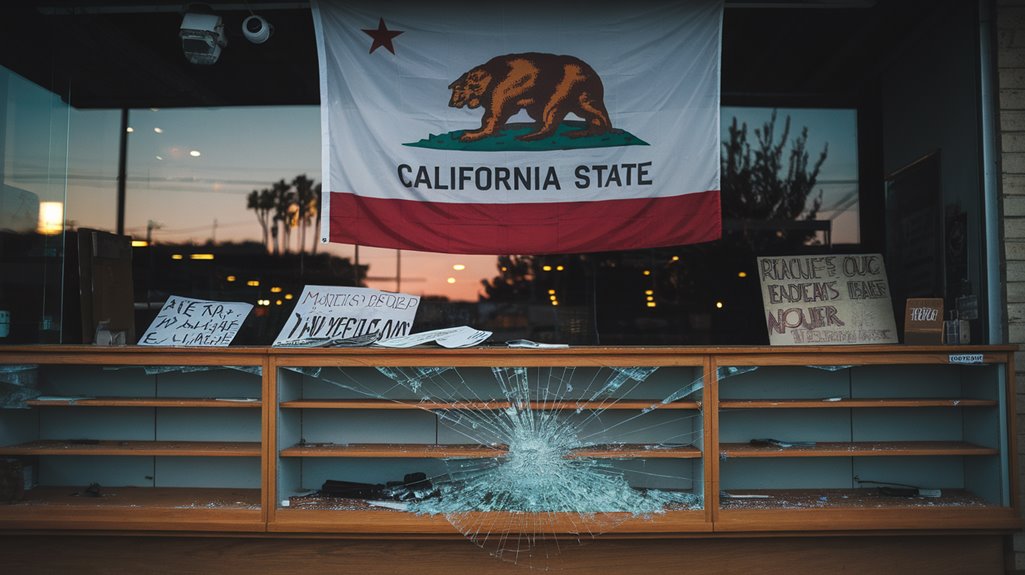
Community advocacy groups across California have mobilized in response to recent court rulings, with anti-gun organizations pushing for stricter enforcement while pro-gun groups challenge purchase restrictions. Local public safety forums reveal a growing urban-rural divide, particularly in Bay Area communities where views on self-defense needs clash with calls for tighter regulation. Neighborhood watch programs are adapting their protocols to address concerns about open-carry practices and changing enforcement guidelines in public spaces.
Local Advocacy Group Actions
Local advocacy groups have mobilized rapidly in response to shifting gun policies, with organizations on both sides of the debate intensifying their efforts. Community outreach initiatives have seen dramatic changes, with advocacy strategies adapting to the evolving legal landscape.
Key developments in local advocacy include:
- Californians for Responsible Gun Laws launching grassroots campaigns focused on state legislation, while Gun by Gun promotes technological solutions for secure storage
- Women Against Gun Violence expanding community-based educational programs to address weapon proliferation concerns
- California Gun Rights Foundation partnering with the NRA to challenge over 80 state regulations through legal channels
The Trauma Foundation continues providing litigation support for local firearm regulations, while public safety coalitions align with police chiefs to maintain existing restrictions.
Public Safety Forum Results
Public sentiment towards firearm policies shows strong support for enhanced regulations across California, particularly in urban areas. Survey data reveals 82.9% of Bay Area residents favor stricter public carry rules, while 72% of Americans support mandatory gun permits.
Community engagement through public safety forums has yielded significant results. Oakland's violence intervention program achieved a 32% reduction in shootings through targeted initiatives. Local police coalitions are advocating for expanded Extreme Risk Protection Orders, citing their effectiveness in preventing school incidents. Additionally, grassroots organizations have filed supporting briefs for SB 452's microstamping requirements, emphasizing improved forensic capabilities. The implementation of new policies reflects strong community backing, with 61.8% of gun owners supporting tax-funded violence reduction programs.
Neighborhood Watch Program Changes
Recent judicial rulings have transformed how Neighborhood Watch programs operate across California, particularly following the landmark *Bruen* decision. Community engagement has evolved to incorporate digital surveillance and data sharing between residents and law enforcement, raising new questions about surveillance ethics.
Key changes to Neighborhood Watch programs include:
- Integration of Flock camera systems, with 480 units deployed in Oakland alone, enabling real-time crime monitoring
- Modernization of alert systems through smartphone apps and email networks for faster community response
- Expanded collaboration between law enforcement and residents in collecting and sharing investigative data
These adaptations reflect shifting dynamics between community safety initiatives and constitutional rights, as Neighborhood Watch groups balance traditional patrol activities with technology-enhanced monitoring systems. Local police departments have adjusted their approaches to accommodate both increased civilian carry and enhanced surveillance capabilities.
Implementation Timeline and Challenges

Since the landmark Bruen decision in 2022, California's gun laws have faced a complex series of implementations and legal challenges. The firearm regulation impacts were immediate, as courts began requiring gun laws to align with historical precedents.
The legal precedent evolution has resulted in significant changes throughout 2023 and 2024. A federal judge blocked California's ban on carrying firearms in most public places just before its January 2024 implementation. While some measures, including an 11% excise tax, took effect, others faced ongoing litigation. The Ninth Circuit upheld stricter concealed carry permit criteria but stayed certain technical requirements. Multiple cases, including Fouts v. Bonta and Duncan v. Bonta, continue to challenge various aspects of state firearm regulations, particularly regarding assault weapons definitions and safety features.
Future Implications for Bay Area Gun Laws
The Bay Area's gun laws face significant reshaping in the wake of ongoing judicial decisions and local policy experiments. Legal challenges continue to test local regulations, particularly regarding concealed carry permits and insurance requirements. San José's innovative insurance mandate could set precedents for other Bay Area jurisdictions.
Three key trends shaping future gun ownership in the region:
- Insurance requirements may become standard across Bay Area cities, following San José's model
- Varying permit enforcement between counties could lead to standardization through court mandates
- Federal court decisions on "sensitive places" will determine the scope of local restrictions
These developments suggest a complex landscape where gun ownership trends will be shaped by both judicial interpretation and local policy innovation, particularly in defining constitutionally permissible regulations.
Frequently Asked Questions
How Do Liability Insurance Requirements Affect Military Veterans With Service Weapons?
Military veterans face the same liability insurance requirements as civilian gun owners, with no special exemptions for service weapons. Their veteran rights do not override state mandates for firearm coverage. Insurance challenges include high premium costs and limited coverage options, as military insurance (SGLI/VGLI) doesn't cover civilian scenarios. Veterans must obtain separate liability policies if their existing insurance is insufficient, facing fines up to $1,000 for non-compliance.
Can Multiple Gun Owners in the Same Household Share One Insurance Policy?
Multiple gun owners can share one policy, with standard homeowners/renters insurance and scheduled personal property coverage both accommodating household gun ownership. Insurance policy sharing extends liability protection to all insured household members under a single plan. Insurers typically require detailed firearm inventories but don't mandate separate policies per owner. Safe storage measures and proper documentation remain essential for coverage, regardless of owner count within the household.
What Happens to Confiscated Firearms After Court-Ordered Surrenders?
Confiscated firearms from court-ordered surrenders undergo a specific process. First, weapons are logged and stored as evidence by law enforcement. They remain in secure storage during any appeal period. If appeals fail, firearms are either destroyed following court authorization, transferred to law enforcement for training, or returned to rightful owners if confiscation orders are reversed. All dispositions require detailed documentation and verification through the Sheriff's Office.
Are Antique or Inherited Firearms Exempt From the New Insurance Requirements?
In a sweeping policy that affects every single firearm in San Jose, both antique firearms and inherited weapons must meet the same insurance requirements as modern guns. Despite their historical or sentimental value, these firearms receive no special exemptions under the ordinance. The only official exemptions are for peace officers (active, reserve, or retired). All other gun owners must maintain liability insurance covering accidental use, regardless of the firearm's age or how it was acquired.
How Do These Regulations Impact Competitive Shooting Sports and Hunting Clubs?
California's regulations greatly impact shooting competitions and hunting clubs. Organizations must guarantee regulatory compliance by verifying all firearms meet current magazine capacity limits and configuration requirements. Clubs can only use 10-round magazines in most events, while previously legal equipment like bullet-button rifles face restrictions. Participants must navigate 30-day purchase limits and special permits. These rules particularly affect competitive shooting sports requiring rapid magazine changes or specialized equipment.
Conclusion
Recent Bay Area gun law rulings paint a complex landscape, where Second Amendment rights meet local safety concerns. Like waves reshaping the shoreline, these decisions continue to mold firearm regulations across San Francisco, Oakland, and San José. Gun owners navigate a shifting maze of insurance mandates, carry permits, and tax requirements. The dust has yet to settle as courts and communities shape the region's evolving relationship with firearms.
